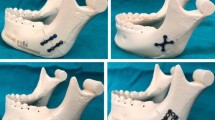Abstract
Purpose
The aim of this study was to comparatively evaluate the use of a three-dimensional (3D) square-shaped plate for the treatment of mandibular angle fractures.
Materials and methods
Synthetic mandible replicas were used to evaluate the effectiveness of the 3D square plate along with three other mandibular angle plating techniques. The plating techniques consisted of: (1) a 3D miniplate (2 × 2 holes, square, 2 mm); (2) a 3D miniplate (6 × 2 holes, curved, 2 mm); (3) two miniplates (four holes, straight, 2 mm and 1.6 mm); and (4) one single miniplate (four holes, straight, 2 mm). Each group was subjected to incisal and homolateral molar region loading by a tensile materials testing machine (Monsanto Tensometer 20). Load stiffness values and peak measurements of the fracture gap distraction at the superior aspect of the mandible were measured. The mean values (±standard deviation) were derived and compared using one-way analysis of variance, with statistical significance set at p < 0.05.
Results
For homolateral molar loading, statistically significant differences existed within groups (p < 0.05). For incisal edge loading, no statistically significant differences were found for stiffness among the fixation methods tested. Gap distraction at the superior aspect of the mandible was limited for three of the groups tested.
Conclusion
Under the conditions tested, the 3D square plate system provided the most favorable mechanical behavior.






Similar content being viewed by others
References
Fonseca R (2005) Oral and maxillofacial trauma (ed 3). Saunders, Philadelphia 486
Prein J, Schilli W, Hammer B et al (1991) Rigid fixation of facial fractures. In: Fonseca RJ, Walker RV (eds) Oral and maxillofacial trauma. Saunders, Philadelphia, pp 1206–1240
Choi BH, Kim KN, Kang HS (1995) Clinical and in vitro evaluation of mandibular angle fracture fixation with the two miniplate system. Oral Surg 79:692–695
Ellis E, Sinn D (1993) Treatment of mandibular angle fractures using two 2.4 mm dynamic compression plates. J Oral Maxillofac Surg 51:969–973
Ellis E (1993) Treatment of mandibular angle fractures using the AO reconstruction plate. J Oral Maxillofac Surg 51:2504
Ellis E III (1999) Treatment methods for fractures of the mandibular angle. Int J Oral Maxillofac Surg 28:243
Shetty V, Caputo A (1992) Biomechanical validity of the solitary lag screw technique for reducing mandibular angle fractures. J Oral Maxillofac Surg 50:63
Gear A, Apasova E, Schmitz J, Schubert W (2005) Treatment modalities for mandibular angle fractures. J Oral Maxillofac Surg 63:655–663
Weingärtner T, Dillmann R (1997) Simulation of jaw-movements for the musculoskeletal diagnoses. Stud Health Technolog Inform 39:401–410
Haug R, Fattahi T, Goltz MA (2001) Biomechanical evaluation of mandibular angle fracture plating techniques. J Oral Maxillofac Surg 59:1199–1210
Antoci A, Voor MJ, Seligson D et al (2004) Biomechanics of external fixation of distal extraarticular fractures. J Orthop Trauma 18:665–673
Champy M, Lodde JP, Jaeger JH et al (1976) Mandibular osteosynthesis according to the Michelet technic. II. Presentation of new material. Results. Rev Stomatol Chir Maxillofac 77:577
Champy M, Lodde JP, Jaeger JH et al (1976) Mandibular osteosynthesis according to the Michelet technic. I. Biomechanicalbases. Rev Stomatol Chir Maxillofac 77:569
Wagner WF, Neal DC, Alpert B (1979) Morbidity associated with extraoral open reduction of mandibular fractures. J Oral Surg 37:97
Chuong R, Donoff RB, Guralnick WC (1983) A retrospective analysis of 327 mandibular fractures. J Oral Maxillofac Surg 41:305
Iizuka T, Lindqvist C, Hallikainen D et al (1991) Infection after rigid internal fixation of mandibular fractures: a clinical and radiologic study. J Oral Maxillofac Surg 49:585
Potter J, Ellis E (1999) Treatment of mandibular angle fractures with a malleable noncompression miniplate. J Oral Maxillofac Surg 57:288
Kroon FH, Mathisson M, Cordey JR et al (1991) The use of miniplates in mandibular fractures. An in vitro study. J Craniomaxillofac Surg 19:199
Choi BH, Yoo JH, Kim KN et al (1995) Stability testing of a two miniplate fixation technique for mandibular angle fractures. An in vitro study. J Craniomaxillofac Surg 23:123
Ellis E, Walker L (1994) Treatment of mandibular angle fractures using two noncompression miniplates. J Oral Maxillofac Surg 52:1032
Schierle HP, Schmelzeisen R, Rahn B et al (1997) One- or two-plate fixation of mandibular angle fractures? J Craniomaxillofac Surg 25:162
Wittenberg J, Mukherjee D, Smith B, Kruse R (1997) Biomechanical evaluation of new fixation devices for mandibular angle fractures. Int J Oral Maxillofac Surg 26:68–73
Helkimo E, Carlsson GE, Helkimo M (1977) Bite force and state of dentition. Acta Odontol Scand 35:297
Fontijn-Tekamp FA, Slagter AP, van der Bilt A (2000) Biting and chewing in overdentures, full dentures, and natural dentitions. J Dent Res 79:1519
Ellis E, Throckmorton GS, Sinn DP (1996) Bite forces before and after surgical correction of mandibular prognathism. J Oral Maxillofac Surg 54:176
Harada K, Watanabe M, Ohkura K et al (2000) Measure of bite force and occlusal contact area before and after bilateral sagittal split ramus osteotomy of the mandible using a new pressure-sensitive device: a preliminary report. J Oral Maxillofac Surg 58:370
Tate GS, Ellis E, Throckmorton GS (1994) Bite forces in patients treated for mandibular angle fractures. J Oral Maxillofacial Surg 52:734
Author information
Authors and Affiliations
Corresponding author
Rights and permissions
About this article
Cite this article
Kalfarentzos, E.F., Deligianni, D., Mitros, G. et al. Biomechanical evaluation of plating techniques for fixing mandibular angle fractures: the introduction of a new 3D plate approach. Oral Maxillofac Surg 13, 139–144 (2009). https://doi.org/10.1007/s10006-009-0163-7
Published:
Issue Date:
DOI: https://doi.org/10.1007/s10006-009-0163-7




